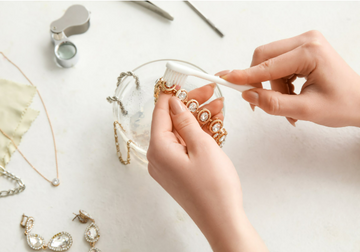We all love that dazzling sparkle of newly cleaned jewelry. But how often should you actually dedicate time to cleaning your precious pieces? The answer isn’t one-size-fits-all. It depends on a few key factors, including how often you wear the jewelry, the types of activities you engage in while wearing it, and the specific materials the jewelry is made of. Let’s break it down to help you create a jewelry cleaning routine that keeps your treasures shining without causing damage.
Why Cleaning Matters: Beyond the Sparkle
Cleaning your jewelry isn’t just about aesthetics; it’s about preserving the longevity and beauty of your pieces. Daily exposure to oils, lotions, sweat, dirt, and even household chemicals can dull your jewelry, damage delicate gemstones, and even corrode certain metals over time. Regular cleaning removes these build-ups, preventing long-term damage and maintaining that fresh-from-the-jeweler look.

Factors Influencing Cleaning Frequency:
- How Often You Wear It: Jewelry worn daily will naturally accumulate more dirt and grime than pieces reserved for special occasions.
- Your Lifestyle: If you lead an active lifestyle and engage in activities like sports, gardening, or cooking while wearing your jewelry, it will likely require more frequent cleaning.
- Cosmetics and Products: Lotions, perfumes, hairsprays, and even sunscreen can leave a residue on your jewelry, dulling its sparkle.
- The Type of Jewelry: Different materials require different levels of care. Porous gemstones like pearls and opals are more susceptible to damage from harsh chemicals and should be cleaned more gently and less frequently.
General Guidelines for Cleaning Frequency:
-
Everyday Jewelry (Rings, Necklaces, Earrings):
- Quick Wipe: A quick wipe down with a soft, lint-free cloth after each wear can remove surface oils and debris.
- Deep Clean: A more thorough cleaning every 1-2 weeks is recommended, especially for rings that come into contact with hand lotions and soaps.
-
Special Occasion Jewelry:
- Clean after each wear to remove any makeup residue, perfume, or sweat.
-
Delicate Jewelry (Pearls, Opals, Turquoise):
- Wipe gently with a soft, slightly damp cloth after each wear.
- Deep clean sparingly (every few months) using a specialized pearl or opal cleaner or a very mild soap solution. Avoid immersing these gems in water for extended periods.
-
Gold and Platinum Jewelry:
- Can tolerate more frequent cleaning with gentle soap and water.
- Consider a professional cleaning every 6-12 months to remove stubborn tarnish and restore their shine.
-
Silver Jewelry:
- Prone to tarnishing, so regular cleaning is essential.
- Use a silver polishing cloth or a silver cleaner to remove tarnish.
Signs Your Jewelry Needs a Cleaning:
- Dull Appearance: The most obvious sign. Your jewelry simply isn’t as sparkly as it used to be.
- Build-up of Residue: You can see a film or residue on the surface of the jewelry, especially around settings and clasps.
- Discoloration: Certain metals, like silver, may develop tarnish (a black or brown discoloration).
- Gemstones Losing Their Luster: Gemstones may appear dull or cloudy.
Cleaning Methods to Use:
- Gentle Soap and Water: A classic and effective method for many types of jewelry. Use mild dish soap and warm water, and gently scrub with a soft-bristled brush.
- Commercial Jewelry Cleaners: Follow the instructions carefully and ensure the cleaner is appropriate for the specific type of jewelry.
- Professional Cleaning: Consider a professional cleaning for valuable or delicate pieces, especially those with intricate settings or vintage designs.
The Takeaway: Listen to Your Jewelry!
The best approach is to observe your jewelry regularly and clean it when it starts to look dull or dirty. Adjust your cleaning frequency based on your lifestyle, the type of jewelry, and the materials it’s made of. A little preventative care will go a long way in preserving the beauty and sparkle of your precious pieces for years to come. And remember, if you’re unsure about the best way to clean a particular piece of jewelry, always consult with a professional jeweler.





